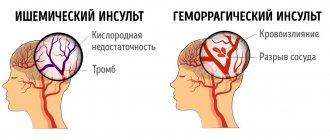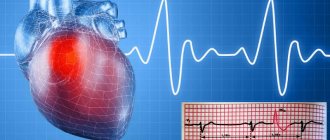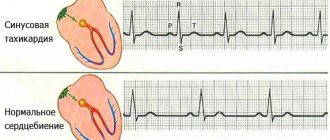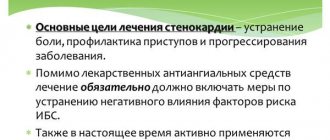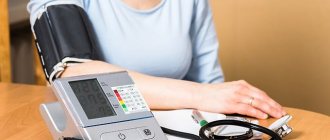Signs of arrhythmias
To have an idea of how you can restore your heart rhythm, it is important to be able to determine the nature of the arrhythmia and know its signs.
To do this, you need to be able to feel the pulse and count it correctly, especially during an attack of atrial fibrillation. Comparison of the pulse and other symptoms will give an idea of how the heart works.
Cardiopalmus
The first sign is a pulse above 90 beats per minute. This may cause the person to sweat a lot. Trembling of fingers on outstretched arms and a nervous state are also signs of an attack of pathological tachycardia. The patient may feel short of breath, and during a severe attack it becomes impossible to count the pulse. The skin turns pale, cold sweat appears, and the fear of death appears.
Bradycardia
Physiological bradycardia is typical for people involved in sports and heavy physical labor. Pathology is indicated when the pulse rate drops below 55 beats per minute, and at 40 beats, urgent medical attention is required. An invariable companion of pathological bradycardia is severe weakness, pallor of the skin and mucous membranes. With a strong decrease in heart rate, convulsions and loss of consciousness may occur.
Extrasystole
Extrasystole does not always require emergency measures. Normally, each person can experience an “extra stroke” up to several times a day. With pathological prolonged extrasystole, medical attention is needed, since in patients with coronary artery disease it can signal the onset of myocardial infarction and other serious conditions. When listening to the pulse after an extraordinary beat, a long pause is observed, which is called compensatory. The patient perceives it as a sinking heart. Extrasystole may also be accompanied by increased rhythm. Possible accompanying symptoms are nausea and shortness of breath.
Atrial fibrillation
The attack is accompanied by a strong heartbeat, this type is called tachysystolic. The patient clearly feels interruptions in the heart, at times an acute lack of air, pain in the heart area and dizziness. The attacks may also be accompanied by a slowing of the pulse or occur at a normal beat rate.
Restoration of heart rhythm by electric current
Maintaining heart rhythm is the task of the conduction system of the heart. The conducting system is a network of atypical cardiomyocytes capable of generating an electrical impulse, conducting it and transmitting it to muscle tissue, that is, a kind of biological electrical network. Therefore, arrhythmia is directly related to the electrical activity of the heart. Having recognized this feature, in the last century they began to actively study the possibility of treating arrhythmias with electric current discharges. The point of such therapy is to “reboot” the entire conduction system.
For this purpose, one of the most common medical devices was created - a defibrillator. The defibrillator has found its main application in resuscitation, where it is used to restore rhythm during ventricular fibrillation, the main cause of clinical death. In some situations, setting low power, the defibrillator is used for less dangerous arrhythmias. But only a doctor can use a defibrillator for any purpose not related to resuscitation.
Anyone who is predisposed to heart rhythm disturbances should not only know what to do in such cases, but also remember the triggering factors in order to avoid them if possible. If you lead your life in accordance with all preventive recommendations, medications and restoration of heart rhythm by electric shock may never be needed.
You need to be very careful with such things as alcohol, smoking, excessive physical and mental stress, poor quality food, and excessive coffee consumption. How to restore heart rhythm in cases where the listed factors provoked arrhythmia is a controversial question
As a rule, it is enough to simply stop the effect of the factor and provide the person with the most comfortable and calm conditions. If such measures are not enough, suspicious symptoms appear or the general condition of the patient worsens, you should either give him a medicine that has been effective in similar cases before, or call an ambulance. Waiting for the rhythm to spontaneously restore means exposing a person to unreasonable risk.
It is impossible to independently restore the heart rhythm with an electric current, even if there is an automatic defibrillator nearby: not all types of arrhythmias are amenable to this treatment, and in some cases the condition even worsens, so electrocardiography must first be performed to clarify the type of rhythm disturbance.
About arrhythmia
Even when a person with arrhythmia feels well, he needs treatment. This should not be left to chance; attacks of arrhythmia must be alleviated. If this fails, then emergency medical care is needed.
The norm is 50-100 beats/min. A decrease in the number of beats is called bradycardia, and an increase in the number of beats is called tachycardia. If additional beats occur between normal heartbeats, this is a symptom of arrhythmia. These symptoms may be felt by the patient, but there may be no signs.
- Malignant. They are life-threatening, they impair blood flow, and there is a lack of oxygen in the brain. Blood pressure also decreases and chest pain is felt.
- Benign. They are not dangerous and therefore do not require serious treatment.
If the disease is not treated, serious problems may occur, such as a heart attack. A person needs emergency medical care, otherwise, in its absence, irreparable consequences may occur.
To reduce the risk of an attack, you need to monitor your health and get rid of the causes that worsen the condition. Arrhythmia usually appears from:
- coffee and energy drinks;
- excessive drinking and smoking;
- stress;
- strong physical activity;
- metabolic disorders;
- heart diseases;
- thyroid diseases;
- infections and fungi;
- menopause period;
- brain diseases.
If you are prone to attacks of arrhythmia, you need to get rid of these factors
A comprehensive examination is important if treatment is necessary
How to restore heart rhythm: effective methods, treatment and prevention
The human heart beats at its own rhythm, changing and adapting to circumstances. But there are also pathologies in his work that lead to unexpected consequences. But it is not always possible to get urgent help from a doctor. Therefore, you need to know how to restore the heart rhythm yourself. For this, there are proven means that allow you to restore your condition in a short time.
About arrhythmia
Even when a person with arrhythmia feels well, he needs treatment. This should not be left to chance; attacks of arrhythmia must be alleviated. If this fails, then emergency medical care is needed.
The norm is 50-100 beats/min. A decrease in the number of beats is called bradycardia, and an increase in the number of beats is called tachycardia. If additional beats occur between normal heartbeats, this is a symptom of arrhythmia. These symptoms may be felt by the patient, but there may be no signs.
Arrhythmias are:
- Malignant. They are life-threatening, they impair blood flow, and there is a lack of oxygen in the brain. Blood pressure also decreases and chest pain is felt.
- Benign. They are not dangerous and therefore do not require serious treatment.
If the disease is not treated, serious problems may occur, such as a heart attack. A person needs emergency medical care, otherwise, in its absence, irreparable consequences may occur.
To reduce the risk of an attack, you need to monitor your health and get rid of the causes that worsen the condition. Arrhythmia usually appears from:
- coffee and energy drinks;
- excessive drinking and smoking;
- stress;
- strong physical activity;
- metabolic disorders;
- heart diseases;
- thyroid diseases;
- infections and fungi;
- menopause period;
- brain diseases.
If you are prone to attacks of arrhythmia, it is necessary to get rid of these factors. A comprehensive examination is important if treatment is necessary.
When do you need help?
The patient may exhibit different symptoms, it all depends on the type of arrhythmia. Typically this condition can be detected by:
- increased or decreased heart rate (over 100 beats/min. or less than 50);
- lethargy;
- shortness of breath;
- “broken” state throughout the body;
- frequent urge to urinate;
- pain in the chest;
- increased sweating;
- fainting;
- respiratory arrest and dilated pupils.
In addition to these symptoms, you also feel weakness, pressing pain in the chest, which can radiate to the jaw, neck, and arms. Anxiety, reaching the point of panic, is likely. Some symptoms can resolve on their own, while others may get worse without medication. If any symptoms appear, you should immediately consult a doctor.
The attack begins suddenly, so you need to know how to restore the heart rhythm. Before the ambulance arrives, assistance must be provided. It is important to take effective measures:
- The patient needs to sit more comfortably, preferably placing a pillow under his back. If this happened on the street, then you can sit him on a bench, on the grass.
- Fresh air is needed, so you need to open the window. It is advisable to remove excess clothing that presses or interferes with normal breathing.
- The following actions also help: you should hold your breath for 14-16 seconds and then cough.
- You can induce vomiting by pressing on the root of the tongue. This makes the situation easier.
- Eat a piece of stale bread.
- You need to apply a wet cold cloth to your face or lower your face into a container of cold water for a few seconds.
- Manual therapy techniques are suitable. It is necessary to press on the eyelids every few seconds.
- For chest pain, Nitroglycerin is used.
- Acupressure is used. To do this, for 2 minutes you need to press your thumb on a point located between the thumb and the wrist of the other hand.
Often such procedures allow you to get rid of unpleasant symptoms. How else can you restore your heart rhythm? For this they use Valocordin, Corvalol, and Valerian. Beta-blockers are recognized as effective - “Anaprilin”, “Concor”, “Egilok”.
The doctor needs to be told about your blood pressure and pulse readings over the past few days. It is also important to mention the probable factors that could lead to this - alcohol, stress, medications. If your pulse is low, you should tilt your head back to ensure a better flow of oxygen. In case of fainting, indirect cardiac massage or artificial respiration is effective.
What should you keep in your first aid kit?
If a person periodically has attacks, then you need to know how to restore the heart rhythm at home. This will quickly eliminate unpleasant symptoms. In your home medicine cabinet you should have medications that restore heart rhythm:
- "Panagin."
- Hawthorn tincture.
- Tablets "Anaprilin".
- Muscle relaxant – “Seduxen”, “Relanium”.
Before using any product, you should read the instructions for the tablets that restore heart rhythm. During an attack, you should not go to work or exercise. You need a state of peace and comfort.
All sedatives can eliminate arrhythmia or reduce symptoms of the disease. They are taken without a doctor's prescription. These are tinctures, potions and tablets. Products with valerian or motherwort are in demand.
How to restore heart rhythm with atrial fibrillation? Your doctor may prescribe antiarrhythmic drugs that reduce the number of attacks and reduce pain. This is “Quinidine”, “Ri.
But these products are toxic. When taking them, it is necessary to monitor the level of potassium and magnesium in the blood, as well as the functioning of the kidneys.
With frequent attacks, stabilization of the rhythm can be performed using an electric current discharge.
How to restore heart rhythm at home if you are intolerant of antiarrhythmic drugs? In this case, the doctor prescribes tranquilizers. They are used for rapid restoration of cardiac output, "Grandaxin", "Elenium". The type of drug and dosage must be prescribed by a doctor.
How to restore heart rhythm with other medications? Homeopathic remedies are effective in eliminating the cause of arrhythmia, which reduces the number of attacks and the severity of symptoms. Patients with various ailments should consume honey, apricots, grapes, raspberries, and currants daily. The products are able to saturate tissues with active ions and also reduce the amount of cholesterol.
Recovery
How to restore pulse and heart rhythm to quickly improve your condition? It is advisable to do this in the first 2 days after the attack. An echocardiogram is needed to check for the presence of clots in the atria. The attack can be quickly stopped with intensive therapy. Drug treatment and electrical stimulation are used.
Danger
With arrhythmia, the functioning of the heart is disrupted; it contracts incorrectly, which causes blood clots to form and “spread” throughout the internal organs. This is how irreversible processes appear. Clots block the blood path in the vessels.
If such a phenomenon occurred in a coronary vessel, then a heart attack occurs, if in the brain - a stroke, in the lung - death. When individual fibers of an organ contract, it may stop. Only with timely treatment will it be possible to get rid of the problem and prevent the development of pathologies.
When considering the topic of how to restore heart rhythm during arrhythmia, you should be aware of prohibited measures. Treatment should be agreed with your doctor. If attacks are frequent, then traditional medicine may be powerless. The doctor prescribes 24-hour Holter monitoring.
First, the reasons that led to the attack are established. You should not take medications on the advice of friends. It is not possible to assess the condition on your own; consultation with a specialist is necessary.
ethnoscience
Is it possible to restore heart rhythm using traditional medicine? They are often considered effective because they eliminate discomfort in a short time:
- Mint. The plant is drunk both during an attack and daily on an empty stomach. Peppermint (3 tablespoons) is poured with boiling water and let the product infuse. During an attack, you can drink fresh mint tea.
- Valerian, motherwort, anise, yarrow. It is advisable to use this collection for those who have an increased heart rate. You need to take 1 tbsp. l. each plant and place in a thermos. 2 liters of boiling water is poured there. You need to drink 0.5 cups before meals - 3 times a day. Regular use makes the heartbeat rhythm healthy.
- Heather. The plant has an excellent effect on the functioning of the heart, calms the nervous system, and relieves spasms of the heart muscle. The decoction is consumed throughout the day instead of tea, and heather infused with alcohol should be used as an emergency treatment measure during an attack.
- Sesame oil, lemon, walnuts. Place chopped lemons in boiling water. You should let it cook for a while. Then add chopped walnuts and sesame oil. Add 3 lemons, oil (9 tbsp) and walnuts (1 cup) to water (100 l). Can be sweetened with honey. The mass should stand in a warm place, and then it is strained. The resulting product is drunk 1 tbsp. l. before eating.
- Apricot kernels, lemon and honey. You need to grind lemons (0.5 kg), apricot kernels (a handful) through a meat grinder. You need to add honey (1/2 cup). The product is used before bedtime, 1 tbsp. l. It restores the functioning of the heart.
- Calendula. The plant can restore heart rhythm. For frequent attacks, you should have a prepared decoction of calendula flowers in the refrigerator. If there are no attacks, you need to drink ½ glass of the decoction every day on an empty stomach.
Traditional medicine will be useful if approved by a doctor. But first a diagnosis is made. You should not self-medicate as this may make the situation worse.
Prevention
What should be done to avoid arrhythmia? In order for the heart rhythm to be normal, it is necessary to change the quality of life. Don't be nervous about little things. It is advisable to replace nervous work with calm work.
It is necessary to adjust the diet by removing fatty, fried, high-calorie foods from it. You should not drink coffee and strong tea, you should eat less sweets. It is necessary to play sports, as it trains the heart. But the load should be moderate.
It is important to avoid alcohol and smoking, as this negatively affects the functioning of the heart.
There is a special exercise that is necessary for the rhythmic functioning of the heart. You take a deep breath, pinch your mouth and nose, and then exhale. This is done when the ears are stuffy. The exercise is performed several times every day.
Conclusion
The heart is one of the main organs. Therefore, you need to pay attention to any failures. If unusual painful symptoms appear, you should consult a doctor. Only this approach is correct.
Source: https://FB.ru/article/388630/kak-vosstanovit-ritm-serdtsa-deystvennyie-metodyi-lechenie-i-profilaktika
Prevention
What should be done to avoid arrhythmia? In order for the heart rhythm to be normal, it is necessary to change the quality of life. Don't be nervous about little things. It is advisable to replace nervous work with calm work. It is necessary to adjust the diet by removing fatty, fried, high-calorie foods from it. You should not drink coffee and strong tea, you should eat less sweets. It is necessary to play sports, as it trains the heart. But the load should be moderate
It is important to avoid alcohol and smoking, as this negatively affects the functioning of the heart.
There is a special exercise that is necessary for the rhythmic functioning of the heart. You take a deep breath, pinch your mouth and nose, and then exhale. This is done when the ears are stuffy. The exercise is performed several times every day.
The heart is one of the main organs
Therefore, you need to pay attention to any failures. If unusual painful symptoms appear, you should consult a doctor.
Only this approach is correct.
What to do to avoid arrhythmia
To train the muscle responsible for the rhythmic functioning of the heart, perform the following exercise. Take a deep breath, close your mouth and nose and try to exhale. They also do this when their ears are blocked. Do the exercise several times daily.
The heart is one of the main organs of the human body. Therefore, any failures in its operation require attention and careful analysis. If your heart stops, its rhythm is interrupted, if you feel a crazy beating in your chest, be sure to consult a doctor. Take care of yourself and your life - your loved ones need you!
Traditional recipes against arrhythmia
As Avicenna said, there are no herbs on Earth that do not heal anything. Each plant can cure a person from a particular disease. We have collected for you the most effective recipes that can restore heart rhythm and get rid of arrhythmia. Some decoctions and tinctures can be drunk as an emergency measure to stop an attack. Others have a medicinal effect, and if you drink them constantly, attacks become rare and not so intense.
- Mint.
This plant can be drunk both during an attack and every day on an empty stomach. Pour boiling water over three tablespoons of peppermint and let steep for a couple of hours. If the attack has already begun, you can drink freshly brewed mint tea. - Valerian, motherwort, anise, yarrow.
This collection is recommended for use by those who suffer from increased heart rate. Take one tablespoon of each ingredient and place in a thermos. Pour two liters of boiling water. Drink half a glass before each meal - three times a day. Regular use of this decoction will restore a healthy heart rate. - Heather.
This plant has a wonderful effect on the functioning of the heart, calms the nerves, and relieves spasms of the heart muscle. The prepared decoction can be drunk throughout the day instead of tea, and heather infused with alcohol can be used as an emergency treatment measure if an attack occurs. - Sesame oil, lemon, walnuts.
Place washed and cut lemons into a small amount of boiling water. Let them cook for a while. After this, add chopped walnuts and sesame oil to the mixture. For 100 ml of water you will need 3 lemons, 9 tablespoons of oil and a glass of walnuts. You can add honey for sweetness. The mass should be kept in a warm place and then strained. Drink the prepared product one tablespoon before each meal. Store the medicine in the refrigerator. It is indicated for people with a slow heartbeat. - Apricot kernels, lemon and honey.
The following recipe will help calm the heartbeat that began due to nervousness. Grind half a kilo of lemons and a handful of apricot kernels through a meat grinder. Add half a glass of honey. Eat the prepared product before going to bed, one tablespoon at a time. It will normalize heart function and calm the nerves. - Calendula.
This plant perfectly restores heart rhythm. If attacks of arrhythmia occur frequently, you need to have a ready-made decoction of calendula flowers in the refrigerator so that you can immediately drink the medicine if necessary. In the absence of attacks, you need to drink half a glass of the decoction every day on an empty stomach.
Remember that traditional medicine recipes can only be useful when determining the true diagnosis. Do not self-medicate - consult a doctor. Only after he makes a diagnosis and prescribes treatment, you can consult with him about additional therapeutic measures in the form of decoctions and tinctures.
First aid for arrhythmias
How to restore heart rhythm on your own? There are rules for first aid. But first of all, you need to call a doctor, since not all types of arrhythmia can be dealt with without the use of medications that restore the heart rhythm.
First aid for tachycardia
The first thing to do is to lay or sit the patient down, remove all constricting clothing that interferes with breathing, and provide him with a flow of fresh air. The following will help to quickly restore your heart rate:
- sedative - tea with mint, lemon balm or motherwort tincture;
- 30 – 50 drops of Corvalol or Valocardin will not only relieve nervous tension, but also dilate blood vessels and slow down the pulse;
- holding your breath - you need to take a deep breath, do not breathe for 5 - 10 seconds, and then exhale and cough;
- washing with cold water, and if possible, just dip your face in a bowl of cold water and hold your breath;
- With a little effort, press on the eyeballs for 5 seconds, then release, repeat several times.
During a severe attack, you can induce vomiting by pressing on the root of the tongue.
How to help with bradycardia?
If a rare heartbeat is accompanied by fatigue, fainting, or weakness, you can provide first aid at home with improvised means that restore normal heartbeat:
- give the patient strong tea or coffee, caffeine will “invigorate” the blood vessels and increase the heart rate;
- You can also use tincture of ginseng or eleutherococcus to improve tone;
- movement and any physical activity will help normalize the rhythm (walking up the stairs, exercises);
- warm bath.
All these activities must be carried out after measuring the heart rate. If the heart rate is below 40 beats, medical attention is required.
Extrasystole and atrial fibrillation
It is impossible to restore rhythm during extrasystole and atrial fibrillation using home remedies. These arrhythmias are signs of serious illnesses, and they can only be treated with medications. Your doctor should tell you how to properly restore your heart rhythm with the help of medications. Only he can prescribe antiarrhythmic drugs, taking into account existing contraindications and concomitant diseases.
To alleviate the condition during an attack, the patient needs to sit comfortably, or even better, lie down, remove constricting clothing and open access to fresh air. In case of a prolonged attack, you must call an ambulance.
During an attack of atrial fibrillation, which can be quite painful, you can try to restore the rhythm by stimulating the vagus - the vagus nerve, which is responsible, in particular, for the innervation of the heart. You need to take a deep breath, pinch your nose and mouth and try to exhale forcefully. This method helps with all types of arrhythmias, but, unfortunately, not for all patients.
Most often, medications are used to restore rhythm in atrial fibrillation. If they are also powerless, electrical cardioversion is used. The patient, immersed in a short sleep, is restored to normal rhythm with the help of a synchronized current discharge. Subsequently, the restored rhythm is maintained using carefully selected drug therapy.
If episodes of atrial fibrillation become significantly less frequent, medications may be discontinued. All medications in this case are aimed at preventing attacks. Sometimes doctors are forced not to treat atrial fibrillation, but only to maintain the heartbeat normal and prevent complications. This tactic is used in severe cases.
Treatment of the heart is not only drug therapy. Weighted physical activity and nutritional correction are necessary measures to maintain normal heart function.
How to restore heart rhythm - classical methods and folk remedies
Atrial fibrillation is a fairly common phenomenon among cardiac pathologies. In this condition, the rhythm of contraction and relaxation of the myocardium is disrupted. The disease is characterized by atrial contraction frequency from 300 to 700 beats per minute. How to restore heart rhythm during arrhythmia at home? Let's try to figure it out.
Why is arrhythmia dangerous?
An increased heart rate is observed in various situations: during nervous excitement, emotional, and physical stress. Heart rhythm disturbance in this case is a temporary phenomenon that goes away on its own, without help. Whereas with atrial fibrillation, restoration of sinus rhythm is required.
What should you do if your pulse quickens and your heart pounds in your chest for no reason? The first thing to do is call an ambulance. You should not take your health lightly, because the heart does not work properly with atrial fibrillation.
The greatest danger of the pathology is that with atrial fibrillation, blood stagnation occurs, and this leads to the formation of a blood clot. The broken blood clot enters the aorta through the bloodstream and is then transported to the brain.
This leads to cardioembolic stroke, resulting in severe brain damage.
Every effort must be made to restore the heart rhythm, since disturbances in the blood supply to the body can cause cardiac arrest.
First aid
Arrhythmia can occur suddenly and go away just as quickly, but this is an alarming signal, so you should not ignore it. It would be a good idea to consult a cardiologist, especially if you have already had heart problems.
In case of arrhythmia attacks, you need to call a doctor, and before his arrival, provide assistance to the patient:
- During an attack of arrhythmia, you need to put the patient on the sofa. If this happened on the street, you need to find a bench and sit the person on it.
- It is important to reassure the patient and refrain from any negative information.
- It is necessary to provide access to fresh air in the room where the patient is located. If any accessory is squeezing your neck, it must be removed.
- To restore the heart rhythm, ask the patient to hold his breath for 15-20 seconds, then clear his throat.
- Vomiting can help with an attack of arrhythmia. It is easy to cause by pressing on the root of the tongue. Such manipulations restore heart rhythm.
- During an attack, you should wash the patient's face and give him cool water to drink. It is even better if the patient immerses his face in a container of cold water.
- You can give the patient a stale crust of black bread to eat, this will help alleviate his condition somewhat.
Important! If the flickering arrhythmia has become permanent, restoring sinus rhythm without medical help is impossible. Long-term hospital treatment under medical supervision is required.
While waiting for the ambulance to arrive, a patient with arrhythmia can be given a drug belonging to the group of beta-blockers:
- Anaprilin,
- Concor,
- Egilok and others.
Restoration of sinus rhythm must be achieved within the first 48 hours after the onset of the attack. If the arrhythmia persists for more than two days, echocardiography is performed. The atria are examined for the presence of blood clots (thrombi).
To stop an attack of arrhythmia, intensive cardiological therapy is used. Sometimes only cardioversion helps. Indications for such measures are acute heart failure, arterial hypotension in patients with cardiac ischemia.
To restore the heart rhythm, two methods are used:
- medications,
- electrical influence.
Drug cardioversion
You can restore your heart rhythm at home with the help of antiarrhythmic medications. But drugs of this profile have potential toxicity. Drug restoration of the heartbeat is technically easier to perform, but it is still not as effective as stabilizing the rhythm with an electric current discharge.
If the arrhythmia becomes permanent, tablets become an ineffective means of normalizing the condition.
The following drugs are used to restore heart rhythm:
- Novocainamide,
- Amiodarone,
- Ibutilide,
- propafenone,
- Dofetilide and others.
Tablets such as Sotalol, Procainamide and Digoxin have less effect than the above drugs.
Electrical cardioversion
This procedure consists of the following: an electrical impulse is applied, which synchronously coincides with the activity of the heart muscle. Electrical cardioversion is performed under anesthesia.
The electrode is placed on the chest, after which periodic discharges are given with a gradual increase in power. The intervals between electrical impulses are at least one minute.
There is another method of electrical stimulation of the heart. In this case, the impulse is passed through a catheter, which is previously inserted into the right atrium through a vein. This procedure does not require the use of anesthesia.
The most dangerous complications after such a procedure are heartbeat disturbances and thromboembolism.
Surgical intervention
If other methods of treating arrhythmia are ineffective, surgical intervention is resorted to. An electrophysiological study of the myocardium and subsequent radiofrequency ablation are performed. Today, treatment of atrial fibrillation with surgery is very effective.
Use of medications
Today, pharmacies offer a wide range of drugs that are effectively used to relieve and treat arrhythmia attacks. Medicines are produced in the form of tablets and for parenteral administration (intravenously and intramuscularly).
In cardiology, the following drugs are widely used to treat cardiac arrhythmias:
Digoxin. The medicine reduces the heart rate and eliminates the causes of the disease. Regular use requires a gradual increase in dose; Verapamil. The product is recommended for use during an attack of tachycardia
Should be used with caution in old age; Adenosine. The drug is administered intravenously, therefore it eliminates the symptoms of arrhythmia within 30-60 seconds; Flecainide
The medicine is widely used for tachycardia.
Important! Regardless of the severity of the disease, medications should be prescribed by a doctor. He individually selects medications, taking into account the symptoms and causes of the pathology, the patient’s condition and the characteristics of his body.
Section materials
October 15, 12:48
The nutritionist named the two main causes of obesity
October 15, 12:43
Phthisiatricians warned of a surge in tuberculosis incidence
October 15, 11:55
New director of the National Medical Research Center named after. Turner spoke about the plans of the institute
October 14, 11:40
COVID from ignorance? Who is to blame for the rise in coronavirus cases?
October 13, 10:48
St. Petersburg hospitals are strengthening COVID-19 prevention measures
How to maintain sinus rhythm?
The restored heart rhythm must be closely monitored to avoid relapses. For this, the patient needs to take antiarrhythmic drugs. Among the most common medications it is worth noting:
Disopyramide; Amiodarone; Flecainide; Novocainamide; Quinidine and others.
During treatment with these drugs, side effects may occur, such as dyspepsia, ventricular tachycardia, and skin lesions. Therefore, you need to take medications strictly as prescribed by a cardiologist and under the supervision of a doctor.
Quite often, arrhythmia leads to the development of cardiac muscle dystrophy. With supportive care this risk can be prevented. Drug treatment helps reduce the symptoms of severe tachycardia.
In addition to maintenance therapy, it is necessary to simultaneously treat the underlying heart disease, which caused the arrhythmia.
Important! Antiarrhythmic drugs are potentially toxic, therefore, while undergoing treatment, it is important to monitor the levels of magnesium and potassium in the blood and check kidney function. A pathology such as atrial fibrillation requires long-term therapy
Medicines are selected by a cardiologist based on research results, the individual characteristics of the patient’s body, the duration of the arrhythmia and the characteristics of the course of the underlying disease.
A pathology such as atrial fibrillation requires long-term therapy. Medicines are selected by a cardiologist based on research results, the individual characteristics of the patient’s body, the duration of the arrhythmia and the characteristics of the course of the underlying disease.
How to Maintain Sinus Rhythm
For atrial fibrillation, the use of anticoagulants is recommended. These drugs include Plavix and Warfarin. These medications reduce the risk of blood clots.
The patient should closely monitor his condition. At the slightest change, be it dizziness, rapid pulse, bleeding or a tendency to bruise, you need to see a doctor and tell about all the symptoms.
